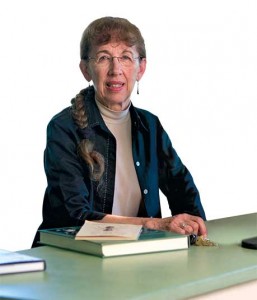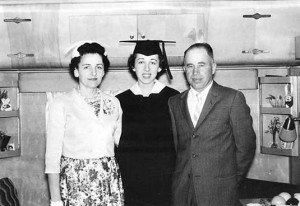Dr. Laurel Hansen may actually be an unparalleled U.S. researcher of all things ants. They’re more than her favorite pest to study. They also pave the road of her career in academia — from the first entomology course she took as an undergrad all the way to her current research of ant behavior and biology.
“I’m particularly interested in ants infesting structures,” Dr. Hansen says. “I also investigate exotic ants that invade the Pacific Northwest.”
Dr. Hansen was the first-born daughter, the eldest of four sisters, in a family of six. Her farming family raised dry-land wheat and cattle in Davenport, Wash.
“Our extended family — aunts, uncles and cousins — all lived close by,” Dr. Hansen explains. “Ours was a close family whose lives revolved around the farm and what it offered.”
“Growing up on a farm 20 miles from the nearest town allowed me to explore nature, and the freedom to investigate a lot of biological topics,” she continues. “Because my father needed help at certain times of the year, I learned to drive all the farm vehicles, plus mow and rake alfalfa hay, herd cattle, bottle-feed orphan sheep and drive our wheat truck from the farm to the grain elevators.”
But she was more than just a hardworking junior farmhand. Dr. Hansen also had a role in what was, at the time, largely referred to as the “woman’s work,” helping her mother with gardening, canning, cooking and raising her younger sisters.
Still, she stresses, “there was time for fun — sleigh riding, swimming in the [Spokane] river, picnics, picking wildflowers, church and Grange activities, and family get-togethers.”
Working on the family farm fostered an interest in both plants and animals, and by the time Dr. Hansen reached college age, the groundwork laid by her childhood — and encouragement by teachers along the way — led to her first course in entomology her sophomore year.
“My interests in biology all rest with my instructors,” Dr. Hansen explains. This includes her 8th grade science teacher as well as numerous other high school teachers.
“I went to a small high school, where there were only 28 in our graduating class. Twenty of us attended all 12 years together — so we knew one another well. We still get together as often as possible,” she adds. “But it was my teachers who brought me down the path to biology, and in college I majored in biology and chemistry.”
Paying it forward
In a sense, Dr. Hansen spent the early part of her academic career paying forward her solid education, earning a bachelor’s of arts teaching degree and certification from Eastern Washington University in 1962 to teach science, social studies and language arts for grades K through 12. After that, Dr. Hansen picked up her master’s degree in entomology at Washington State University (WSU). This, in turn, was followed by 13 years teaching at a community college, before taking a year off from coursework and returning again to spend five years conducting research at WSU to earn her Ph.D.
Dr. Hansen still continues on at the community college, having logged a total of 47 years (and counting).
“I’ve also served as an adjunct at Eastern Washington University and Washington State University to assist with research and graduate students,” Dr. Hansen says. “By 1985, my education was always mixed with teaching, between my bachelor’s degree and my master’s and my doctorate.
“Teaching has always been my first love and since 1985, I’ve been able to successfully juggle teaching with research opportunities.”
Playing favorites
At press time, Dr. Hansen is heavily involved in researching structure-infesting ants, as well as the exotic ants that invade the Pacific Northwest. She studies ants from all over the world, but admits she does have a favorite: The carpenter ant (Camponotus spp.).
The research Dr. Hansen conducts trickles down from the lab to industry practice, particularly where ants are concerned. She’s had an insider’s look at the industry from decades spent researching pest insects. In that time, she’s seen changes, advancements and challenges old and new.
One challenge Dr. Hansen has observed during her career is the infusion of integrated pest management (IPM) into pest management practices.
“Incorporating biology, behavior and ecology into understanding the management of insects will always be important,” she explains. “There is more to management than just chemical control.”
And she should know, having spent plenty of time teaching chemical control fundamentals.
“After earning my master’s degree, I became involved with pesticide education at all levels,” Dr. Hansen says. “And after my Ph.D., I became involved with urban pest management because my research topic was ants. I learned quickly about management strategies — and, because of my teaching background, became an effective presenter in the industry.”
Anyone who’s had the opportunity to attend one of Dr. Hansen’s speaking engagements at a pest management industry event knows she can command a classroom with wit, dry humor and is able to convey big concepts with lots of information in a short period of time.
Dr. Hansen counts her study of ants on the island of Guam with university colleague Dr. Ross Miller as one of her major academic life achievements, “but I’ve collected ants from all over,” she says.
That’s singled out as merely one academic achievement, but with a personal history that’s entrenched in research, the tally of achievements is great, formidable and ongoing. Dr. Hansen also points to her influence on other like-minded individuals looking to follow in her footsteps.
“Working with students and helping them pursue careers in the field of teaching at any level or into fields of entomology or medicine is one of the professional accomplishments of which I’m very proud,” Dr. Hansen says.
Family ties
Although single for the past 20 years, Dr. Hansen notes that her 36-year marriage produced her “greatest gifts” — daughter Devorah, son Darren, two grandchildren and 4 great-grandsons. Dr. Hansen says she’s also close to her three younger sisters, and is the guardian of the youngest, who is developmentally disabled. Another sister assists Dr. Hansen on her numerous research projects.
Her love of travel dovetails nicely with the research she conducts. “One of my favorite places is Belize, where I’ve traveled a number of times to snorkel in the beautiful warm waters and to investigate the insects — particularly ants — in the jungle,” Dr. Hansen says. “The Mayan ruins there are also fascinating.”
Add to this a love of the theater and performing arts, reading historical fiction, gardening flowers and vegetables, hiking, and a deep involvement in her local church — and you’re looking at an example of a life well-lived, and the rich history of a doctor of ant investigations whose story has several chapters yet to be written.
You can reach Senior Editor Will Nepper at wnepper@northcoastmedia.net or 216-706-3775.


Very nicely written article. I was a follower of Dr. Hansen during my time as a pest control company owner on Long Island in New York where I did a lot of carpenter ant service. Dr. Hansen’s research (which led to practical treatment methods) was invaluable in helping me produce quality treatments and reduced callbacks.